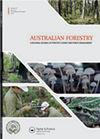Evaluating the potential for timber production of young forests of Eucalyptus spp. clones used for bioenergy: wood density and mechanical properties
IF 1.2
4区 农林科学
Q3 FORESTRY
引用次数: 3
Abstract
ABSTRACT The Brazilian bioenergy industry is well developed and has numerous highly productive Eucalyptus spp. clones, the wood of which may suit the timber industry. We screened the mechanical wood properties of six bioenergy Eucalyptus spp. clones from young forests to find ones suitable for the timber industry. We evaluated shear strength, parallel compressive strength, strength and stiffness on static bending, and wood density. Eucalyptus camaldulensis clones had low strength and stiffness for their wood density and are less suitable for timber products. However, clones from E. urophylla and E. urophylla × E. grandis had specific strength and stiffness close to the values reported for mature Eucalyptus wood. Their average density ranged from 0.54 g cm−3 to 0.68 g cm−3 and, while the lightest wood had properties close to those of mature Pinus elliottii trees, the clone with the densest wood produced material similar to mature E. urophylla. We conclude that these clones have distinct wood properties, each with different potential applications. With better understanding of this timber source, young clonal Eucalyptus forests could be an asset to the timber industry in Brazil, substituting pine wood and providing raw material close to the main consumer markets.评价桉树无性系幼林用于生物能源的木材生产潜力:木材密度和机械特性
巴西生物能源产业发达,拥有大量高产的桉树无性系,其木材可能适合木材工业。通过对6个来自幼林的生物能源桉树无性系的机械性能进行筛选,寻找适合木材工业的无性系。我们评估了抗剪强度、平行抗压强度、静态弯曲强度和刚度以及木材密度。山梨树无性系的强度和刚度相对于木材密度较低,不适合作为木材制品。而尾叶和尾叶×大尾叶无性系的比强度和刚度接近于成熟桉树木材的值。它们的平均密度在0.54 ~ 0.68 g cm−3之间,最轻的木材具有与成熟的油松相近的特性,而最密的木材具有与成熟的尾叶松相近的特性。我们得出结论,这些克隆具有不同的木材特性,每种特性都有不同的潜在应用。随着对这种木材来源的更好了解,年轻的无性系桉树林可以成为巴西木材工业的一笔资产,取代松木并提供接近主要消费市场的原材料。
本文章由计算机程序翻译,如有差异,请以英文原文为准。
求助全文
约1分钟内获得全文
求助全文
来源期刊

Australian Forestry
FORESTRY-
CiteScore
3.70
自引率
4.80%
发文量
15
审稿时长
>12 weeks
期刊介绍:
Australian Forestry is published by Taylor & Francis for the Institute of Foresters of Australia (IFA) for scientific, technical, and professional communication relating to forestry in the Asia Pacific.
 求助内容:
求助内容: 应助结果提醒方式:
应助结果提醒方式:


